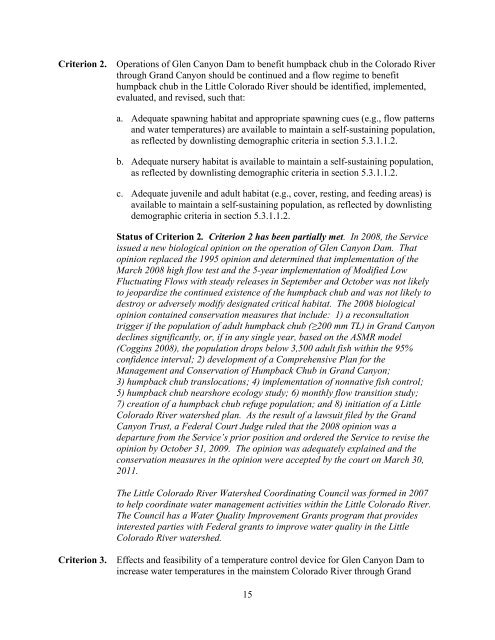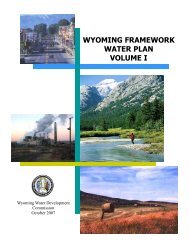Humpback chub (Gila cypha) - Upper Colorado River Endangered ...
Humpback chub (Gila cypha) - Upper Colorado River Endangered ...
Humpback chub (Gila cypha) - Upper Colorado River Endangered ...
You also want an ePaper? Increase the reach of your titles
YUMPU automatically turns print PDFs into web optimized ePapers that Google loves.
Criterion 2.<br />
Operations of Glen Canyon Dam to benefit humpback <strong>chub</strong> in the <strong>Colorado</strong> <strong>River</strong><br />
through Grand Canyon should be continued and a flow regime to benefit<br />
humpback <strong>chub</strong> in the Little <strong>Colorado</strong> <strong>River</strong> should be identified, implemented,<br />
evaluated, and revised, such that:<br />
a. Adequate spawning habitat and appropriate spawning cues (e.g., flow patterns<br />
and water temperatures) are available to maintain a self-sustaining population,<br />
as reflected by downlisting demographic criteria in section 5.3.1.1.2.<br />
b. Adequate nursery habitat is available to maintain a self-sustaining population,<br />
as reflected by downlisting demographic criteria in section 5.3.1.1.2.<br />
c. Adequate juvenile and adult habitat (e.g., cover, resting, and feeding areas) is<br />
available to maintain a self-sustaining population, as reflected by downlisting<br />
demographic criteria in section 5.3.1.1.2.<br />
Status of Criterion 2. Criterion 2 has been partially met. In 2008, the Service<br />
issued a new biological opinion on the operation of Glen Canyon Dam. That<br />
opinion replaced the 1995 opinion and determined that implementation of the<br />
March 2008 high flow test and the 5-year implementation of Modified Low<br />
Fluctuating Flows with steady releases in September and October was not likely<br />
to jeopardize the continued existence of the humpback <strong>chub</strong> and was not likely to<br />
destroy or adversely modify designated critical habitat. The 2008 biological<br />
opinion contained conservation measures that include: 1) a reconsultation<br />
trigger if the population of adult humpback <strong>chub</strong> (≥200 mm TL) in Grand Canyon<br />
declines significantly, or, if in any single year, based on the ASMR model<br />
(Coggins 2008), the population drops below 3,500 adult fish within the 95%<br />
confidence interval; 2) development of a Comprehensive Plan for the<br />
Management and Conservation of <strong>Humpback</strong> Chub in Grand Canyon;<br />
3) humpback <strong>chub</strong> translocations; 4) implementation of nonnative fish control;<br />
5) humpback <strong>chub</strong> nearshore ecology study; 6) monthly flow transition study;<br />
7) creation of a humpback <strong>chub</strong> refuge population; and 8) initiation of a Little<br />
<strong>Colorado</strong> <strong>River</strong> watershed plan. As the result of a lawsuit filed by the Grand<br />
Canyon Trust, a Federal Court Judge ruled that the 2008 opinion was a<br />
departure from the Service’s prior position and ordered the Service to revise the<br />
opinion by October 31, 2009. The opinion was adequately explained and the<br />
conservation measures in the opinion were accepted by the court on March 30,<br />
2011.<br />
The Little <strong>Colorado</strong> <strong>River</strong> Watershed Coordinating Council was formed in 2007<br />
to help coordinate water management activities within the Little <strong>Colorado</strong> <strong>River</strong>.<br />
The Council has a Water Quality Improvement Grants program that provides<br />
interested parties with Federal grants to improve water quality in the Little<br />
<strong>Colorado</strong> <strong>River</strong> watershed.<br />
Criterion 3.<br />
Effects and feasibility of a temperature control device for Glen Canyon Dam to<br />
increase water temperatures in the mainstem <strong>Colorado</strong> <strong>River</strong> through Grand<br />
15
















